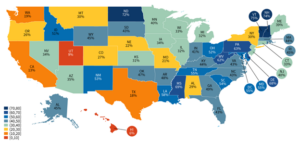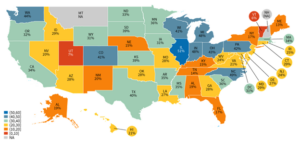Table of Contents
A recent ONC blog post showed physicians have widespread access to data from their state’s prescription drug monitoring program (PDMP). According to a 2021 national survey of office-based physicians, more than three-quarters of physician prescribers reported checking the PDMP prior to prescribing controlled substances to a patient for the first time. Prescriber use laws and ongoing efforts to integrate electronic health record (EHR) systems with state PDMPs likely contributed to high levels of PDMP use among physicians.
Despite physicians’ increased access to PDMP data from their state’s PDMP, their participation in interstate data sharing remains limited. While nearly all PDMPs electronically share data with other states, as of 2021, less than one-third of physicians nationally reported requesting to view data from other states prior to prescribing controlled substances and 1 in 5 were unsure whether this request was typically made. These findings suggest physicians that aren’t fully leveraging existing state data sharing capabilities may not be viewing complete controlled substance prescription histories for patients who received care or dispensed prescribed medications in other states.
Interstate Data Sharing
Interstate data sharing—an effective tool for confirming a treatment plan and monitoring for drug diversion and misuse—is particularly important for bordering states where it’s not uncommon for patients to cross state lines to receive care. Given that there may be differences in the perceived value of interstate data sharing depending on physicians’ proximity to a border or whether they practice in a location hard hit by the opioid epidemic, it is perhaps unsurprising that rates of interstate data sharing vary at the state level. The share of physicians who reported requesting to view data from other states prior to prescribing controlled substances ranged from 6% of physicians in Hawaii to about 75% of physicians in North Dakota, New Hampshire, and Vermont—states that each border 3 other states. However, rates were as low as 21% to 55% in Colorado, Missouri, and Tennessee—states that border 7 to 8 other states—which suggests physicians in these states may not be capturing complete controlled substance prescription histories for their patients.
There are several factors beyond perceived value of interstate data sharing that may impact physicians’ ability to view PDMP data from other states. For instance, while all states except for California currently share data with other states, the number of interstate partners varies. As of 2022, a majority of state PDMPs were connected to at least one hub, or data sharing system—such as RxCheck or PMP InterConnect—that enables the exchange of PDMP data across state lines. However, only 31 states reported sharing data with more than 30 states through these connections.

Figure 1: Percent of office-based physicians engaged in interstate data sharing, by state, 2019-2021
PDMP-EHR Integration
Physicians are increasingly gaining access to PDMP data through EHR systems that are integrated with their state PDMP, making the information more accessible at the point of care. In 2021, more than one-third of physicians nationally reported accessing the PDMP through their EHR, a 62% increase from 2019. However, progress has varied substantially at the state level. As of 2019 and 2021, rates of PDMP-EHR integration ranged from 6% of physicians in Vermont to 51% of physicians in Illinois. Many of the highest rates of integration occurred in states that received funding between 2012 and 2016 from the Substance Abuse and Mental Health Services Administration (SAMHSA) to integrate PDMP data with health IT systems including EHRs and pharmacy dispensing software systems. However, there are various factors that contribute to different rates of progress towards integration at the state-level including, but not limited to, differences in EHR developer capabilities to integrate with PDMPs, particularly those connected with interstate data sharing hubs or that can support a separate integration for interstate exchange.

Figure 2: Percent of office-based physicians who access PDMP data through their EHR, by state, 2019-2021
Existing capabilities to integrate with PDMP software matter a lot. There are several off-the-shelf PDMP software products as well as state specific PDMPs. While there are a few different options to support integration – such as through third party integration vendors or other technology services products – an EHR developer’s support to integrate with any one or all PDMP technology can be crucial to achieving integration. Some research shows that the scale of PDMP integrations across EHRs varies by developer. The number of PDMP integrations one EHR supports may be impacted by the size of its user base and the number of different states in which the EHR is predominantly used.
An analysis of the EHR technology developers reported in the 2021 survey shows variation in market share and PDMP integration by developer. The table below shows how EHR developer market share relates to PDMP integrations. The size and scale of an EHR developer may enable it to support many types of integrations across different PDMP software, whereas the opposite could be argued for EHR developers with fewer clients and limited capacity to support integration. About half of physicians who used an EHR from a market leading developer reported they were able to access PDMP data from their EHR, whereas less than 1 in 5 physicians with any other EHR reported having this capability. More standards-based integration methods may enable more integrations across all EHRs and states. To remove barriers to integration, ONC is engaged in ongoing work to develop standards and implementation guidance to support in-state and interstate exchange of PDMP data.
Table 1: Market Share and PDMP-EHR Integration by EHR Developer in 2021
| EHR | Market share %^ | % Physician prescribers reporting PDMP integration |
| Market leaders* | 66% | 47% |
| Others | 34% | 18% |
Source: Authors’ analysis of data from the 2021 National Electronic Health Records Survey Public Use File.
Notes: ^Among office-based physicians who reported use of an EHR (88% of sample). *Market leaders include Allscripts, athenahealth, Cerner, eClinicalWorks, Epic, and NextGen Healthcare.




More Stories
Punching Through History: A Spotlight on Boxing Culture in England’s Reading
The Link Between Vitamin E Intake and Parkinson’s Disease
Tips and Techniques for Moving Past Binge Drinking